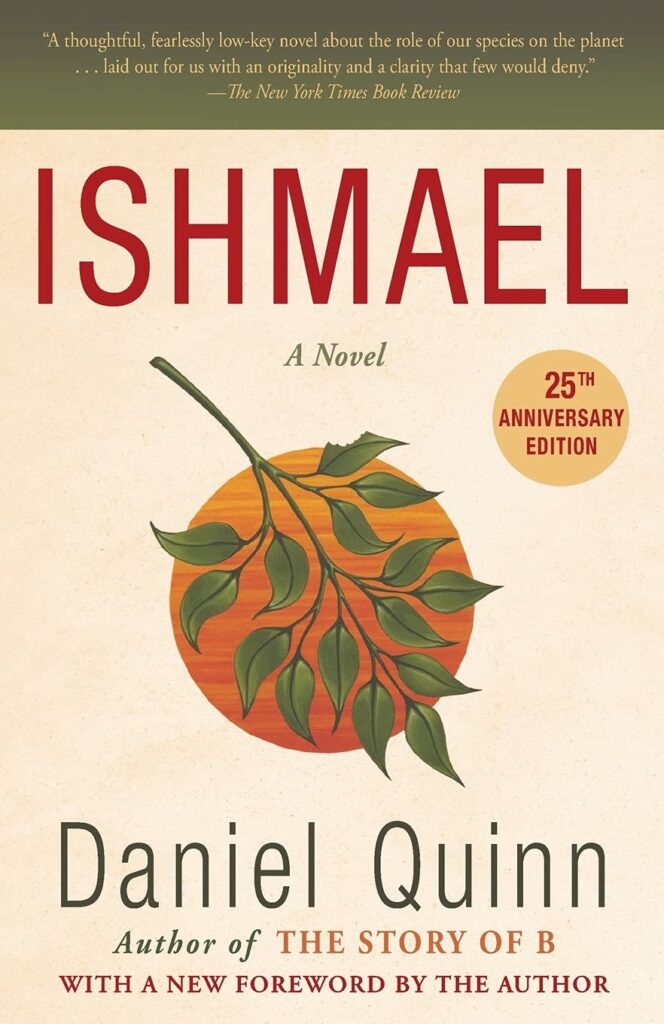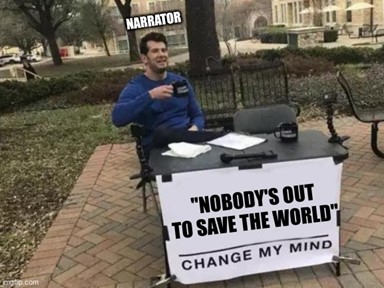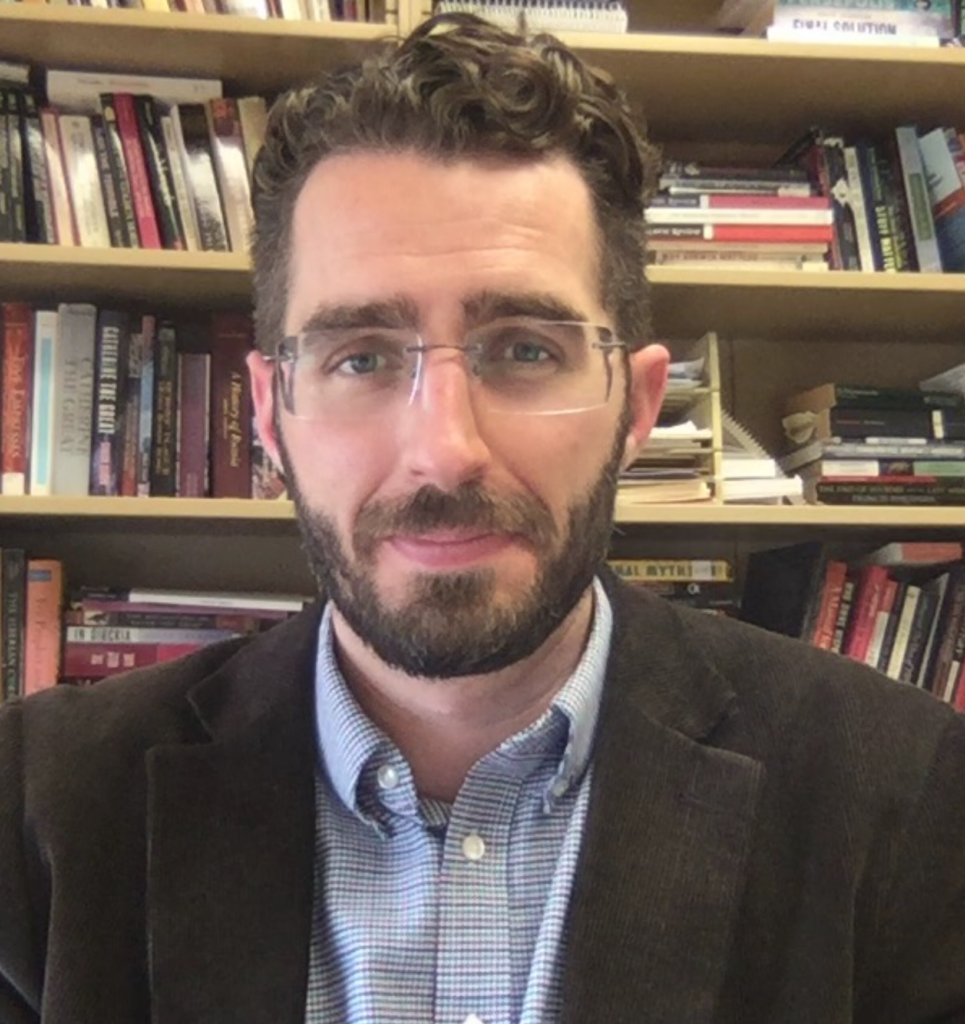By Mark Soderstrom
“I just can’t believe you made us read an entire book about a talking gorilla.”
Such was the comment, at least as it remains stamped in memory five years later, that one student had about my decision to begin our Global Environmental History course with Daniel Quinn’s Ishmael. The 1992 novel is about an encounter between a middle-aged man and his teacher, an erudite silverback who goes by the name Ishmael. Contrary to my student’s comment, though, this is a telepathic gorilla, not a talking one. Had Quinn made Ishmael talk, I jokingly replied, I would not have assigned the book.
Joking aside, my student’s comment raised an important question: why begin a history course with a novel, let alone this one?
 In brief, I think Ishmael is a useful tool to help students consider the nature of history. Relatively few of the undergraduates I teach come to college having thought much about history as a discipline, or even about the basic distinction between history and the past. Whereas the past is everything that has come before, history is the study of that past. History is something we produce, and do, in the present; it is a means of making sense, of finding meaning by sifting through the chaos of everything that together constitutes the past and organizing it into a meaningful, truthful narrative. History, in other words, is about storytelling. This is a basic point, but it is one that students benefit from being given time to dwell on, particularly early in the semester.
In brief, I think Ishmael is a useful tool to help students consider the nature of history. Relatively few of the undergraduates I teach come to college having thought much about history as a discipline, or even about the basic distinction between history and the past. Whereas the past is everything that has come before, history is the study of that past. History is something we produce, and do, in the present; it is a means of making sense, of finding meaning by sifting through the chaos of everything that together constitutes the past and organizing it into a meaningful, truthful narrative. History, in other words, is about storytelling. This is a basic point, but it is one that students benefit from being given time to dwell on, particularly early in the semester.
Just as students come gradually to appreciate the work of storytelling at the core of the discipline of history, so too does the unnamed narrator of the novel. He is a grouch. Once inspired by the idealism of the 1960s, he has since grown jaded, unable to shake the thought that “Nobody’s out to save the world, because nobody gives a damn about that world, that was just a bunch of goofy kids talking. Get a job, make some money, work till you’re sixty, then move to Florida and die” (5). The novel begins as he chokes on his breakfast over an ad in the newspaper: “TEACHER seeks pupil. Must have an earnest desire to save the world. Apply in person” (3). Apply in person he does, spurred on by a combination of curiosity and peevishness. He had once, we learn, hoped to find a teacher to break his disillusionment but has given up on that. Expecting to unmask a charlatan, he trudges to the nondescript office building listed in the ad. Instead, he finds Ishmael. After recovering from his shock that the teacher from the ad is a telepathic gorilla, he becomes Ishmael’s pupil. He learns that Ishmael’s subject of study is captivity, perspective on which he has gained from years of confinement in a zoo and menagerie. Most humans, Ishmael teaches, are themselves captives, but “of a civilizational system that more or less compels you to go on destroying the world in order to live” (28). They tend not to see their captivity because “Mother Culture” nurtures them with myths that tell them that the world was made for them – and is therefore theirs to use, and abuse, as they see fit.
The dialogue between the grumpy narrator and his equally grumpy gorilla guru is sometimes stilted and plodding – as students enjoy pointing out – but I find that it works well in the environmental history classroom. Quinn forces readers to consider the anthropocentrism fundamental to many modern narratives and does so all the more effectively by having a nonhuman protagonist steer the conversation. Students, for example, regularly cite Ishmael’s claim that people tend to frame the story of evolution in “mythical” terms as particularly memorable. To prove his point, the gorilla asks the narrator, who denies that the modern world has a creation myth, to explain the evolution of life. When the narrator concludes his account with “and finally man appeared,” Ishmael pounces. “And you,” he asks, “an intelligent and moderately well-educated person, would you have me believe that this isn’t a myth?” (55-56). Ishmael then offers a similar account the evolution of life, but told from the perspective of a jellyfish – and ending with “but finally jellyfish appeared!” (60). As one student remarked, “I was captivated by the realization that our story of creation can be deemed as mythical as that of any other civilization. I felt the same astonishment the narrator must have felt as I followed the story he told into the tape recorder just to have Ishmael break it apart.”

Meme by Holly Vice, a student in the class.
It is through exchanges like this one that Ishmael not only helps students consider the narrative work of history but do so while grappling with what environmental historian Donald Worster memorably calls the “infamous ‘e’ words”: evolution, ecology, environment, and economy (245). Considering those fundamental concepts critically and in dialogue with one another, after all, is what programs in environmental studies and courses in environmental history are for.
Another advantage of this novel is simply that it is accessible and fun. Students approaching the semester, like the narrator approaching the nondescript office building, do not see the telepathic gorilla coming. They have thoughts. They share them. They do so in class discussion, in memes on our class website, and outside of class. (“Oh, you’re taking Global Environmental History. Get ready for the gorilla.”) Moreover, because Quinn uses much of the novel to consider the agricultural revolution, it works well at the beginning of a course in which technology and attempts to control nature are basic themes. Although the novel oversimplifies and is somewhat dated, its oversimplifications and dated passages, combined with the unexpected plot, make it more inviting than a more complex, let alone scholarly, piece for students to discuss and critique. That they are able to do so at the beginning of the semester, during those pivotal weeks when the various habits of the semester – above all, which students talk regularly in discussion and which do not – are still taking shape, is another reason I keep assigning the book.
Among the more frequent criticisms that students make of Ishmael is what might be called the “So what?” question. Some simply want the gorilla to tell us what to do. One explained that she found the novel’s conclusion underwhelming. Rather than stressing the importance of “teaching others” about the power of the narratives that shape our lives, she would have preferred that the gorilla “offered real suggestions of actions we can take.”

Meme by Holly Vice, a student in the class.
The dichotomy that undergirds this point – between “teaching others” and “real suggestions” – is itself cause for reflection. In the face of such devastating challenges like climate change and accelerating biodiversity loss, why all this talk about storytelling? For many students, the encounter with environmental history can be shocking, even depressing. Having grown accustomed to thinking about modern history in terms of narratives of liberation and progress, they find it disconcerting to question those narratives. Some, like the novel’s narrator, jump to the conclusion that humans are irredeemably flawed. And they say so in class discussion. But usually one of their peers will note that the novel anticipates and rejects this conclusion. “There’s nothing fundamentally wrong with people,” Ishmael tells the narrator. “Given a story to enact that puts them in accord with the world, they will live in accord with the world” (89).
Things are not so simple, of course, but the claim, and the novel more generally, is an invitation to discussion. And students need to discuss the mythical narratives that enable binary habits of thought that erect walls between the classroom and the “real world” and, for that matter, between nature and culture, between humans and nature, and the like. Moreover, because a large portion of the students in my class are preparing for teaching careers, the novel can offer them needed encouragement about the utility of their future work. By foregrounding the power of the narratives we tell about humans and nature – past, present, and future – it is a helpful, even hopeful, reminder of the power of storytelling and of the “real world” work of the humanities.
![The narrator after learning from Ishmael: You know, I'm something of a captive myself [dialogue text with a screenshot of Willem Dafoe].](https://www.asle.org/wp-content/uploads/Holly-Vice-meme-3.jpg)
Meme by Holly Vice, a student in the class.
 Mark A. Soderstrom is Associate Professor and Chair of History at Aurora University, where he also directs the Environmental Studies and Sustainability major.
Mark A. Soderstrom is Associate Professor and Chair of History at Aurora University, where he also directs the Environmental Studies and Sustainability major.
